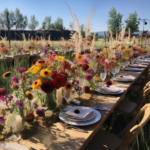Flowers have always been a source of inspiration for the world of fashion, bringing a touch of nature’s elegance to the clothing and accessories we wear. From the intricate embroidery of haute couture to the casual prints of everyday wear, floral designs have woven their way into the fabric of fashion history. This article explores the enduring influence of floral motifs in fashion, tracing their journey from the runway to our everyday wardrobes.
Historical Roots of Floral Fashion
Floral patterns in fashion can be traced back to ancient civilizations where flowers symbolized various cultural and spiritual meanings. In ancient Egypt, floral motifs adorned the garments of the elite, representing fertility and rebirth. Similarly, in China, the chrysanthemum and peony were popular motifs in traditional silk robes, symbolizing longevity and prosperity.
During the Renaissance, floral designs became a significant part of European fashion. Elaborate tapestries and richly embroidered fabrics often featured intricate floral patterns, showcasing the wearer’s wealth and status. The Victorian era further cemented the popularity of florals in fashion, with delicate botanical prints and lacework reflecting the era’s romantic sensibilities.
Florals on the Runway
Floral patterns have been a staple on the fashion runway, with designers continuously finding innovative ways to incorporate them into their collections. Renowned designers like Christian Dior, Alexander McQueen, and Valentino have all showcased the versatility of florals in their haute couture creations.
Christian Dior: Dior’s iconic 1947 “New Look” collection featured full skirts and cinched waists adorned with floral prints and embroidery, embodying post-war optimism and femininity. His love for flowers, particularly roses, was evident in his designs, which often drew inspiration from his own garden.
Alexander McQueen: Known for his avant-garde approach, McQueen often used florals in unexpected ways. His 2007 Spring/Summer collection, “Sarabande,” featured dresses adorned with real flowers, creating a striking and ephemeral beauty that highlighted the delicate and transient nature of blooms.
Valentino: The house of Valentino is synonymous with romantic, floral elegance. Their collections frequently include floral lace, embroidery, and prints, epitomizing timeless beauty and sophistication. The use of florals in Valentino’s designs often evokes a sense of ethereal grace and luxury.
Modern Interpretations and Everyday Wear
While high fashion showcases the artistic potential of floral motifs, everyday fashion has embraced florals in a more accessible and wearable manner. Floral prints are a perennial favorite in casual wear, from summer dresses and blouses to scarves and swimwear.
Spring and Summer Collections: Florals are a staple of spring and summer fashion, symbolizing renewal and vibrancy. Light, airy fabrics like cotton and chiffon often feature bright floral patterns, making them perfect for warm weather. Brands like Zara, H&M, and Forever 21 regularly include floral pieces in their seasonal collections, offering affordable options for fashion enthusiasts.
Fall and Winter Florals: Florals are not confined to the warmer months. Designers have adapted floral patterns for fall and winter by using darker, richer color palettes and heavier fabrics. Deep burgundy, navy, and forest green floral prints on velvet, wool, and knitwear bring a touch of nature’s beauty to colder seasons.
Accessories and Footwear: Floral influences extend beyond clothing to accessories and footwear. Floral-printed bags, shoes, and jewelry add a feminine and whimsical touch to any outfit. Brands like Ted Baker and Cath Kidston are known for their distinctive floral designs, which have become a hallmark of their collections.
The Cultural Impact of Floral Fashion
Floral fashion is not just about aesthetics; it carries cultural significance and emotional resonance. Florals can evoke nostalgia, femininity, and a connection to nature. They can also make powerful statements, as seen in the floral crowns of the 1960s counterculture movement, symbolizing peace and love.
In contemporary fashion, florals are often used to celebrate diversity and inclusivity. Designers draw inspiration from a wide range of floral traditions, incorporating motifs from different cultures to create a global tapestry of floral fashion. This cross-cultural exchange enriches the fashion landscape and honors the universal appeal of flowers.
Sustainability and Florals in Fashion
With the growing awareness of sustainability in fashion, florals have found a new role in promoting eco-friendly practices. Many designers are turning to sustainable materials and ethical production methods, using natural dyes and organic fabrics to create floral prints. This shift not only reduces the environmental impact of fashion but also aligns with the natural beauty and purity that floral motifs represent.
The influence of flowers in fashion is a testament to their timeless appeal and versatility. From the grandeur of runway couture to the simplicity of everyday wear, florals continue to inspire and captivate. They connect us to nature, evoke emotions, and reflect cultural stories, making them a cherished element in the world of fashion. As we look to the future, the enduring allure of floral designs will undoubtedly continue to blossom, bringing beauty and elegance to our lives.


